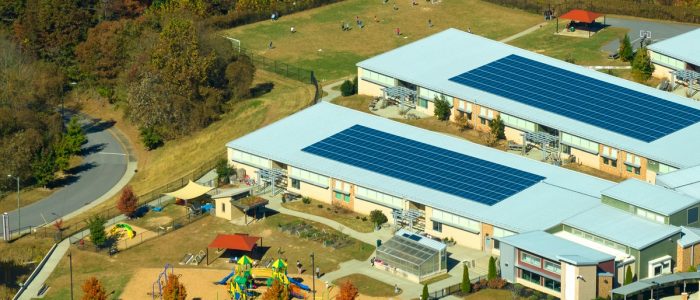Schools across the globe continue to turn to commercial solar power as a sustainable energy solution that aligns with their mission to educate future generations about environmental protection. Solar energy provides a clean, renewable source of power and offers tangible cost savings that could fund critical educational initiatives.
By installing solar panels, schools can significantly reduce their carbon footprint, demonstrating leadership in the fight against climate change while inspiring students to adopt eco-conscious practices. The transition to solar energy contributes to long-term energy independence, shielding institutions from fluctuating energy prices and ensuring a more stable financial future. The benefits of commercial solar power for schools is a brighter, more sustainable tomorrow for their communities.
Reducing Energy Costs Significantly
Switching to solar energy allows schools to achieve considerable reductions in their long-term energy expenses. Installing solar panels lets institutions generate electricity on-site, lowering their monthly utility bills significantly. With rising electricity prices, schools with solar panels enjoy reliable and predictable energy costs.
Cost savings from solar power can contribute to higher budgets for academic and extracurricular programs. Schools can allocate these funds to improve technology, resources, and infrastructure. This financial relief ensures more investment in activities directly benefiting students and teachers.
Environmental Sustainability
Adopting solar power allows schools to lower their carbon footprint, significantly promoting environmental conservation. Solar energy is a clean resource that produces no harmful greenhouse gas emissions during use. By transitioning to this renewable alternative, schools actively contribute to combating climate change.
Students learn firsthand about sustainability when schools adopt energy-efficient technologies such as solar panels. Integrating renewable energy showcases a commitment to protecting the planet for future generations. It inspires schools to implement other eco-friendly practices across operations.
Educational Opportunities for Students

Solar programs serve as educational tools, offering hands-on learning opportunities for student involvement. Renewable energy aligns closely with science, technology, engineering, and mathematics (STEM) education. These projects help students apply theoretical knowledge to practical energy solutions.
Interactive solar-related learning fosters students’ understanding of sustainability, innovation, and technological possibilities. This approach cultivates curiosity about challenges facing energy and climate. It also promotes problem-solving skills relevant to real-world applications and environmental responsibility.
Supporting Local Communities
Solar projects often create opportunities for community collaboration, aligning schools with local energy initiatives. Partnering with green energy solutions promotes growth within communities while generating positive connections. Solar installations exemplify how institutions can take steps to foster stronger, more united neighborhoods.
Educational initiatives surrounding solar installations encourage discussions between students, parents, and the broader community. Such programs reinforce schools’ roles as agents of meaningful environmental change. Community-oriented approaches amplify outreach efforts and nurture collective ecological awareness.
Reducing Operational Disruptions
One of the main benefits of schools adopting commercial solar power systems is that they can operate with minimal interruptions compared to traditional power grids. Many commercial solar setups include battery storage systems, ensuring stable energy availability during outages. This reliability enhances daily school operations by maintaining consistent power.
Administrators benefit from energy independence achieved through solar panel installations, mitigating challenges associated with grid instability. Reliable power empowers schools to sustain teaching, essential services, and safety measures without external disruptions. Simpler management boosts operational efficiency and stability in the long term.
Enhancing School Public Image

Solar power installation prioritizes sustainability and environmental responsibility. A school’s renewable energy commitment demonstrates values related to progressive action, corporate responsibility, and conservation. This transparency generates goodwill among families, sponsors, and educators.
Positive environmental alignment boosts students’ pride in their educational environment, fostering greater investment in institutional missions. Schools with renewable energy programs gain reputational advantages as pioneers of positive systemic changes. Leadership in solar adoption inspires broader actions across communities.
Financial Incentives and Grants
Many schools benefit from incentives and grants encouraging the adoption of renewable energy systems such as solar power. Government initiatives and tax benefits help offset initial installation costs, making solar investments more accessible. These programs increase the possibility of transitioning to renewable energy sources.
Schools can explore tailored financial incentives supporting solar installation projects through state and federal resources. These packages empower institutions to adopt efficient energy solutions while maintaining manageable budgets. Thoughtful financial planning enhances the affordability and scalability of going solar.
Simplified Solar Integration
Working with professionalcommercial solar panel installers ensures seamless integration tailored specifically to a school’s needs. Experts assess factors such as location, energy usage, and budget to recommend optimal setups. Professional oversight guarantees systems are compliant, safe, and cost-efficient.
Installers also handle installation and maintenance, simplifying implementation for educational institutions. These partnerships lead to reliable energy management practices while offering schools confidence in renewable choices. Supported adoption strengthens the overall transition to sustainable energy models.
Long-Term Maintenance Benefits
Solar power systems require straightforward maintenance, especially when schools choose high-quality panels and reliable technology partners. With the right maintenance, schools can benefit from:
- Extended System Lifespan: Regular maintenance ensures solar panels and related equipment remain in optimal condition, significantly prolonging their operational life. This means schools and organizations can rely on their solar systems for decades without frequent replacements.
- Consistent Energy Output: Routine inspections help identify and address potential issues early, ensuring the system continues to produce energy efficiently and at maximum capacity.
- Reduced Costs: Minimal maintenance requirements translate to lower long-term costs, with fewer repairs and reduced technician interventions, making solar power a cost-effective solution.
- Operational Reliability: Proper care reduces the likelihood of unexpected breakdowns, ensuring steady energy generation and minimizing disruptions to daily operations.
- Environmental Benefits: By maintaining solar systems for the long term, organizations sustain their commitment to renewable energy, reducing their carbon footprint and contributing to a healthier environment.
- Enhanced Return on Investment (ROI): With increased durability and efficiency, solar systems provide a higher ROI, ensuring that the upfront investment pays off.
Preparing for the Future
Adopting renewable energy technologies like solar power prepares schools to meet future challenges effectively. Sustainable energy ensures institutions remain adaptable despite evolving environmental, economic, and energy landscapes. Schools demonstrate forward-thinking approaches by making decisions rooted in innovation.
Investments in renewable solutions reflect long-term planning toward resilience and institutional improvement. Schools ready to address sustainability issues will lead in educational settings worldwide. Solar power emphasizes commitment to excellence, setting standards for academic and environmental progress.
Commercial solar power in schools is a transformative step toward a more sustainable and cost-efficient future. Schools can allocate more funds toward educational programs, facility upgrades, and other needs. This shift demonstrates a commitment to environmental protection, inspiring students to recognize the importance of renewable energy and sustainability in combating climate change.
This forward-thinking approach enhances the school’s reputation for innovation and responsibility while emphasizing a long-term investment in self-sufficiency. With commercial solar power, schools create a foundation for excellence in education and environmental progress, addressing current challenges while securing a brighter and more sustainable future.


